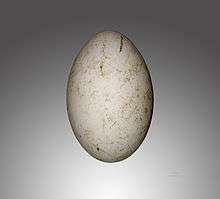Cape vulture
The Cape vulture or Cape griffon (Gyps coprotheres), also known as "Kolbe's vulture", is an Old World vulture in the family Accipitridae. It is endemic to southern Africa, and is found mainly in South Africa, Lesotho, Botswana, and in some parts of northern Namibia. It nests on cliffs and lays one egg per year. Since 2015, it has been classified as Endangered.
| Cape vulture | |
|---|---|
 | |
| At the Rhino and Lion Nature Reserve, Cradle of Humankind, Gauteng, South Africa | |
| Scientific classification | |
| Kingdom: | Animalia |
| Phylum: | Chordata |
| Class: | Aves |
| Order: | Accipitriformes |
| Family: | Accipitridae |
| Genus: | Gyps |
| Species: | G. coprotheres |
| Binomial name | |
| Gyps coprotheres | |
| Synonyms | |
| |
Description
.jpg)
_(20831086742).jpg)
This large vulture is of a creamy-buff colour, with contrasting dark flight- and tail-feathers. The adult is paler than the juvenile, and its underwing coverts can appear almost white at a distance. The head and neck are near-naked. The eyes are yellowish, and the bill is black. Juveniles and immatures are generally darker and more streaked, with brown to orange eyes and red neck.[1]
The average length of adult birds is about 96–115 cm (38–45 in) with a wingspan of 2.26–2.6 m (7.4–8.5 ft) and a body weight of 7–11 kg (15–24 lb). The two prominent bare skin patches at the base of the neck, also found in the white-backed vulture, are thought to be temperature sensors and used for detecting the presence of thermals. The species is among the largest raptors in Africa, next to the lappet-faced vulture. After the Himalayan griffon vulture and the cinereous vulture, the Cape vulture is the third largest Old World vulture.[3][4]
Habitat and distribution

The Cape vulture occurs in Angola, Botswana, Lesotho, Mozambique, South Africa, and Zimbabwe. Formerly, it could also be found in Namibia and Swaziland. Vagrants are occasionally recorded from the Democratic Republic of the Congo and Zambia.
The species usually breeds and roosts on cliff faces in or near mountains, from where it can fly long distances in search of the large animal carcasses on which it specializes.[1] Tracked specimens in Namibia were found to have home ranges 11,800–22,500 km2 (4,600–8,700 sq mi) in extent.[5]
In the Eastern Cape of South Africa, Cape Vultures were more likely to occupy cliff nest sites on ledges with a smaller depth and at a higher elevation, surrounded by conspecifics.[6]
Conservation and threats
.jpg)
The Cape vulture has been declining steadily since at least the 1980s, when it was first categorized as Threatened. Between 1992 and 2007 the species declined by 60-70%[7] in South Africa alone. It was later upgraded to Vulnerable and, in 2015, to Endangered. As of 2013, estimates of total population size assume about 4,700 pairs or 9,400 mature individuals.[1]
The species is considered to be impacted by a large number of threats. A decrease in the amount of large carrion (particularly during nesting), poisoning (targeted or inadvertent), electrocution or collision with cables on electricity pylons (the most common cause of death in ringed birds[5]), loss of foraging habitat, and unsustainable harvesting for traditional uses are thought to be the most important factors.[1] A source of poisoning specific to many vultures, including the Cape vulture, is the drug Diclofenac and related compounds, which is used to treat arthritis in cattle, and which leads to kidney failure in vultures who consume carcasses of treated cattle.[5]
On the 20th of June 2019, the carcasses of 468 white-backed vultures, 17 white-headed vultures, 28 hooded vultures, 14 lappet-faced vultures and 10 cape vultures, altogether 537 vultures, besides 2 tawny eagles, were found in northern Botswana. It is suspected that they died after eating the carcasses of 3 elephants that were poisoned by poachers, possibly to avoid detection by the birds, which help rangers to track poaching activity by circling above where there are dead animals.[8][9][10][11]
References
- BirdLife International (2015). "Gyps coprotheres". IUCN Red List of Threatened Species. 2015: e.T22695225A84339218.
- Forster, J. R. (1798). "Le Chasse-siente, der Rothjäger. No. 10 (V. Coprotheres)". F. le Vaillant's Naturgeschichte der afrikanischen Vögel. Halle: Bey Fried. Christoph Dreyssig. pp. 35–37.
- James Ferguson-Lees; Christie; Franklin; Mead; Burton (2001), Raptors of the World, Houghton-Mifflin, ISBN 0-618-12762-3
- "Cape vulture facts". Arkive.org. Archived from the original on 2008-10-16.
- Simmons, R. E.; Brown, C. J.; Kemper, J. (2015). Birds to watch in Namibia: red, rare and endemic species. Windhoek, Namibia: Namibian Ministry of Environment and Tourism, and The Namibian Nature Foundation.
- Pfeiffer, M. B.; Venter, J. A.; Downs, C. T. (2017). "Cliff characteristics, neighbour requirements and breeding success of the colonial Cape Vulture Gyps coprotheres". Ibis. 159 (1): 26–37. doi:10.1111/ibi.12428.
- "Gyps coprotheres (Cape Griffon, Cape Vulture)". IUCN Red List of Threatened Species. Retrieved 2018-02-22.
- "Over 500 Rare Vultures Die After Eating Poisoned Elephants In Botswana". Agence France-Press. NDTV. 2019-06-21. Retrieved 2019-06-28.
- Hurworth, Ella (2019-06-24). "More than 500 endangered vultures die after eating poisoned elephant carcasses". CNN. Retrieved 2019-06-28.
- Solly, Meilan (2019-06-24). "Poachers' Poison Kills 530 Endangered Vultures in Botswana". Smithsonian. Retrieved 2019-06-28.
- Ngounou, Boris (2019-06-27). "BOTSWANA: Over 500 vultures found dead after massive poisoning". Afrik21. Retrieved 2019-06-28.
Further reading
External links
| Wikimedia Commons has media related to Gyps coprotheres. |
